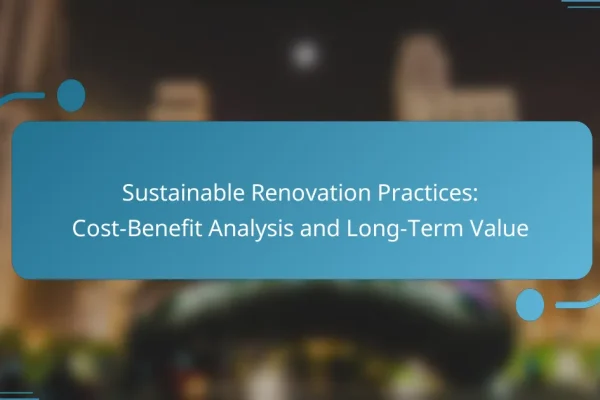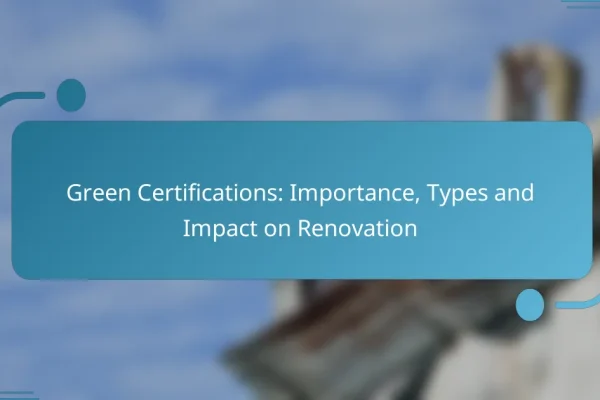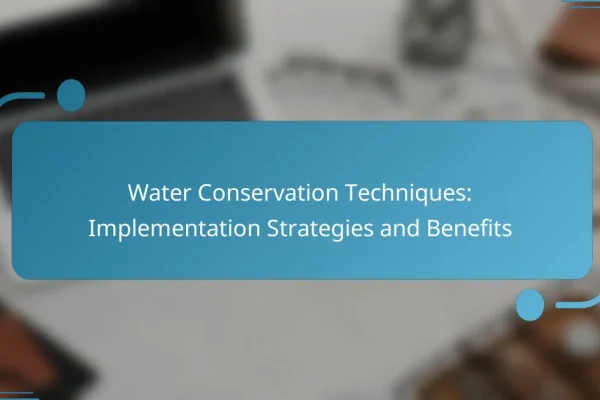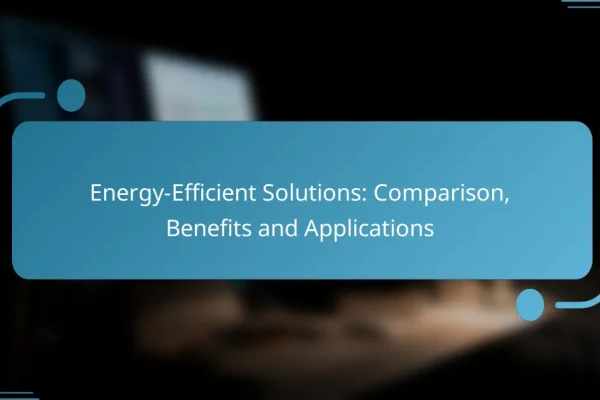What are the best sustainable home renovation practices?
The best sustainable home renovation practices focus on reducing environmental impact while enhancing energy efficiency and resource conservation. Key strategies include using energy-efficient insulation, recycled materials, water-saving fixtures, solar panels, and low-VOC paints.
Energy-efficient insulation
Energy-efficient insulation helps maintain comfortable indoor temperatures and reduces heating and cooling costs. Consider materials like spray foam, cellulose, or fiberglass, which can significantly lower energy consumption.
When selecting insulation, look for products with high R-values, indicating better thermal resistance. Proper installation is crucial; even the best materials won’t perform well if not installed correctly.
Recycled materials usage
Using recycled materials in renovations minimizes waste and reduces the demand for new resources. Options include reclaimed wood, recycled metal, and repurposed bricks, which can add character and sustainability to your home.
Check local suppliers for reclaimed materials or visit salvage yards. Incorporating these materials can often be cost-effective while supporting local economies and reducing your carbon footprint.
Water-saving fixtures
Water-saving fixtures, such as low-flow faucets, showerheads, and dual-flush toilets, significantly reduce water consumption without sacrificing performance. These fixtures can lead to substantial savings on water bills over time.
When choosing fixtures, look for products with the WaterSense label, which indicates they meet EPA standards for efficiency. Installing these fixtures is typically straightforward and can be a simple upgrade during renovations.
Solar panel installation
Installing solar panels is a powerful way to harness renewable energy and reduce reliance on fossil fuels. Solar systems can significantly lower electricity bills and may qualify for government incentives or rebates.
Consider your roof’s orientation and shading when planning installation, as these factors affect efficiency. A professional assessment can help determine the best system size and placement for your home.
Low-VOC paints
Low-VOC (volatile organic compounds) paints are essential for improving indoor air quality during renovations. These paints emit fewer harmful chemicals, making them safer for both occupants and the environment.
When selecting low-VOC paints, check labels for certifications and choose products that meet stringent environmental standards. This choice not only benefits health but also contributes to a more sustainable home renovation.
How can I choose eco-friendly materials for renovation?
To choose eco-friendly materials for renovation, prioritize products that are sustainably sourced, non-toxic, and energy-efficient. Look for certifications and labels that indicate environmental responsibility, ensuring your choices contribute to a healthier home and planet.
Certified sustainable wood
Certified sustainable wood comes from forests that are managed according to strict environmental standards. Look for certifications such as FSC (Forest Stewardship Council) or PEFC (Programme for the Endorsement of Forest Certification) to ensure the wood is sourced responsibly.
When selecting wood, consider its lifecycle impact, including transportation emissions and durability. Opt for locally sourced wood to minimize carbon footprint and support local economies.
Reclaimed materials sourcing
Reclaimed materials are salvaged from old buildings or structures, reducing waste and the need for new resources. Using reclaimed wood, bricks, or fixtures can add character to your renovation while promoting sustainability.
When sourcing reclaimed materials, check the condition and safety of the items. Ensure they meet local building codes and regulations, and consider visiting local salvage yards or online marketplaces specializing in reclaimed goods.
What are the costs associated with sustainable renovations?
The costs of sustainable renovations can vary significantly based on the materials and methods chosen. While initial expenses may be higher, the long-term benefits often justify the investment.
Average cost of eco-friendly materials
Eco-friendly materials typically range from 10% to 30% more expensive than conventional options. For instance, recycled steel or sustainably sourced wood may cost more upfront but offer durability and lower maintenance over time.
When budgeting for sustainable renovations, consider the type of materials you plan to use. Options like bamboo flooring or low-VOC paints can be more costly, but they contribute to a healthier indoor environment and reduce your carbon footprint.
Long-term savings on energy bills
Investing in sustainable renovations can lead to significant savings on energy bills, often reducing costs by 20% to 50% over time. Energy-efficient windows, insulation, and appliances can drastically lower heating and cooling expenses.
To maximize savings, consider installing solar panels or energy-efficient heating systems. While the initial investment may be substantial, many homeowners see a return on investment within a few years through reduced utility bills and potential tax incentives.
What are the local regulations for sustainable renovations?
Local regulations for sustainable renovations vary significantly by region and often include building codes, permit requirements, and environmental standards. Homeowners should familiarize themselves with these regulations to ensure compliance and maximize the benefits of their renovations.
Building codes in California
California has stringent building codes aimed at promoting sustainability and energy efficiency. The California Building Standards Code (Title 24) includes provisions for energy conservation, water efficiency, and materials sustainability. Homeowners should consult local building departments to understand specific requirements applicable to their renovation projects.
Key aspects of California’s building codes include energy efficiency standards for insulation, windows, and HVAC systems. Compliance with these codes can lead to lower utility bills and a reduced environmental footprint.
Permits for solar installations
In California, installing solar panels typically requires a building permit and may also need an electrical permit. Homeowners must submit plans that demonstrate compliance with local codes and regulations. It’s essential to check with the local authority having jurisdiction (AHJ) to understand the specific documentation and fees involved.
Permitting processes can vary by municipality, so homeowners should allow ample time for approvals. Some regions may offer expedited permitting for solar projects, which can streamline the installation process and reduce downtime.
How do I find qualified contractors for sustainable renovations?
To find qualified contractors for sustainable renovations, start by seeking professionals with experience in green building practices and certifications. Look for contractors who prioritize eco-friendly materials and energy-efficient designs, as they will be better equipped to meet your sustainability goals.
Green building certification
Green building certifications, such as LEED (Leadership in Energy and Environmental Design) or BREEAM (Building Research Establishment Environmental Assessment Method), indicate that a contractor has met specific sustainability standards. When hiring, check if the contractor holds any relevant certifications, as this can assure you of their commitment to sustainable practices.
Additionally, certified contractors often have access to resources and knowledge about the latest sustainable technologies and materials, which can enhance the quality of your renovation. Consider asking for their certification details during the interview process to gauge their expertise.
Local contractor directories
Utilizing local contractor directories can help you find professionals who specialize in sustainable renovations. Websites like Angie’s List, HomeAdvisor, or local green building associations often provide listings of contractors along with customer reviews and ratings.
When searching these directories, filter for contractors who specifically mention sustainability or green building in their profiles. This targeted approach can save time and ensure you connect with qualified professionals who align with your renovation goals.
What are the benefits of sustainable home renovations?
Sustainable home renovations offer numerous advantages, including reduced environmental impact and long-term cost savings. By utilizing eco-friendly materials and energy-efficient systems, homeowners can enhance their living spaces while contributing positively to the planet.
Increased property value
Investing in sustainable renovations can significantly boost your property’s market value. Homes equipped with energy-efficient appliances, solar panels, and sustainable materials often attract buyers willing to pay a premium for lower utility costs and reduced environmental footprints.
For instance, properties with Energy Star ratings or LEED certifications can see value increases of 5-15% compared to traditional homes. This trend is particularly strong in urban areas where eco-conscious buyers are more prevalent.
Improved indoor air quality
Sustainable renovations can lead to better indoor air quality, which is crucial for health and comfort. Using low-VOC (volatile organic compounds) paints, natural materials, and proper ventilation systems helps reduce pollutants and allergens in the home.
Incorporating features like green roofs or indoor plants can further enhance air quality. Homeowners should consider materials that are certified for low emissions to ensure a healthier living environment, especially for families with children or individuals with respiratory issues.









